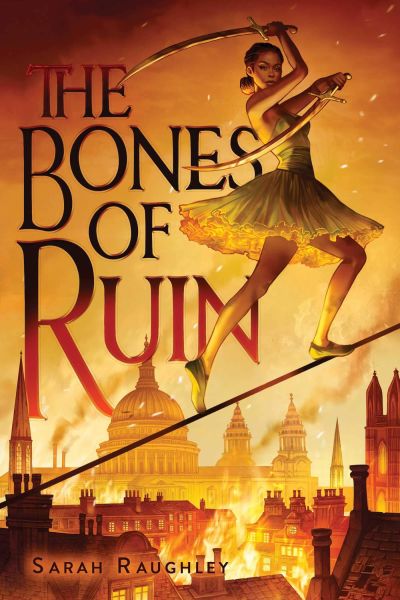A Rare and Precious Metal
The Bones of Ruin
By Sarah Raughley

17 Sep, 2021
Sarah Raughley’s 2021 The Bones of Ruin is a historical fantasy novel.
Iris is the Coolie Company’s star attraction; she’s a daredevil ropewalker who appears utterly blind to the risks she takes far above the audience’s heads. In fact, the amnesiac African woman takes no risks at all. Unbeknownst to the audience and her employer, Mr. Coolie, Iris has a great secret. She cannot be killed.
This is a knack that makes Iris and persons like Iris very valuable to members of the Enlightenment Committee.
The members of the Committee earned their vast fortunes with gumption and hard work. After all, knocking off rival claimants to vast inherited fortunes takes cunning and effort! The Committee is therefore comprised of people who are determined to get what they want when they want it, and willing to do whatever it takes to achieve their goals.
This is a fine approach for individuals. It doesn’t work as well for a team; who gets to decide on goals and tactics? The last vigorous exchange of views concerning leadership reduced the Committee from fourteen members to seven. While the remaining members have not yet agreed who is to lead, they do at least agree that the question should be resolved in some way that does not put the Committee itself at risk.
This is where Iris and those like her come in. Just as Iris has a healing factor that renders her immune to death itself, so other people in 19thcentury England have their own marvelous gifts: fire-breathing, healing touch, shape-shifting, and anthropophagy, to mention just a few. Rather than risk their own lives, the Committee will set teams of “Fanciful Freaks” against each other. Let the Tournament of Freaks determine who is to lead.
Resolving the matter of leadership is of paramount important. The Committee is convinced that previous civilizations as grand as that of the 19thcentury have risen and fallen. The same doom looms for modern civilization. The Committee is determined to shape the world to come … but that will happen only if a collection of power-mad sociopaths can somehow decide which of them is to lead.
And only if their pawns do not decide there is more to be won from allying with each other against their supposed masters.
~oOo~
You may wonder why, if the Committee is so terrible, the Freaks agree to work for them in the first place. The answer is simple: the Freaks for the most part have very little choice in the matter.
The Committee’s vast plan raises a question that bothered me when I first read the Foundation trilogy. How can one be certain the architect of a new society does not embody the very flaws that are dooming the current order? Just as Seldon was a product of the Empire, and his values presumably reflected late Imperial values, so too are the Committee members products of relentless imperialism. They may see themselves as grand visionaries, but the only thing that distinguishes them from the other heartless Social Darwinists of their era is the unearned wealth that allows them to turn their whims into actions.
However, where Asimov seemed to take the position that Seldon was probably right, author Raughley makes it fairly clear that the Committee is probably wrong. The members of the Committee range from the outright monstrous to those who have convinced themselves that the ends justify the means. The book offers no support for the Committee’s belief that they should be the architects of the next cycle of civilization; rather, it gives a lot of evidence for the thesis that none of them should be.
If this book had focused on the Committee, I don’t think I could have been able to read it. But the focus here is on the folks that the Committee sees only as tools. I was rooting for them!
Much fiction set in the 19th century paints a rather sunny view of the period by choosing as protagonists the wealthy and aristocratic, Raughley’s novel shows us the bottom of the social pyramid. The story is told from the perspective of people who might — to take an example that appears in the book — have been carried off from their homeland to be put on display in a zoo. As a consequence, the novel raises the same question as Jemison’s Fifth Season series, which is “would it be so terrible if this particular civilization collapsed?” In both cases, there’s no obvious answer. How to weigh the death and misery caused by the system against the mega-deaths that would ensue in a collapse?
This book would be a tremendous downer if it weren’t for the characters, who are sympathetic, and the writing, which is skillful.
Bones of Ruin is available here (Amazon US), here (Amazon Canada), here (Amazon UK), here (Barnes & Noble), here (Book Depository), and here (Chapters-Indigo).
